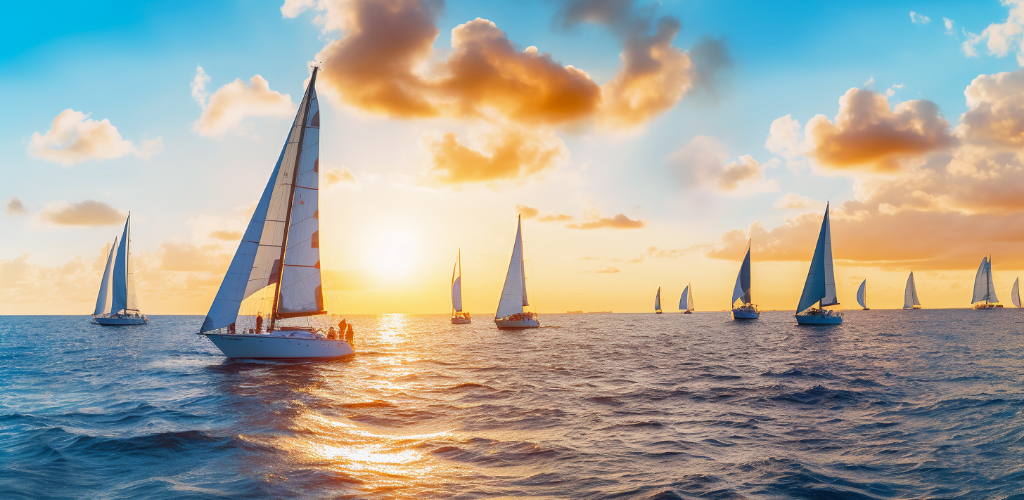There’s just something about sailboats, isn’t there? The way they glide gracefully over the water, their sails billowing in the wind, is a sight to behold. Sailboats have a charm that is both timeless and captivating, making them a favorite amongst water sports enthusiasts. From small dinghies to luxurious yachts, the world of sailboats is as varied as it is fascinating. This guide aims to explore this diversity, offering you a glimpse into the different types of sailboats that dot our waters.
The Beauty and Function of Sailboats
On the surface, sailboats are the epitome of beauty and elegance. But did you know that they’re also marvels of engineering? Unlike other types of boats, sailboats harness the power of the wind to propel themselves forward. This makes them an eco-friendly, sustainable mode of transportation. What’s more, they’re deeply intertwined with our history, having been used for centuries for trade, exploration, and recreation. Can you think of any other type of boat that combines aesthetics, functionality, and historical significance so seamlessly?
Compared to motorboats, sailboats offer a tranquil and serene boating experience. The gentle lapping of waves against the hull, the soft rustling of sails in the wind – it’s an experience that’s hard to match. And let’s not forget the sheer beauty of these vessels. With their sleek lines and towering masts, sailboats are a sight to behold.
Factors Determining the Types of Sailboats
So, what factors determine the types of sailboats? Well, it’s a combination of design, size, number of hulls, keel type, and rigging. The design of a sailboat plays a crucial role in its performance and functionality. For instance, a flat-bottomed sailboat will have a different performance and purpose than a round-bottomed one.
Size is another factor. From small dinghies that can accommodate just one or two people, to massive yachts that can host a large party, sailboats come in all sizes. The number of hulls – that is, the main body of the boat – can also vary. Monohull sailboats have just one hull, while multihull sailboats, such as catamarans and trimarans, have two or three hulls respectively.
The type of keel – a flat surface on the bottom of the boat that helps maintain balance – can also influence the type of sailboat. Some sailboats have a full keel that runs the length of the boat, while others have a fin keel that is shorter and more streamlined. Finally, the rigging – the system of ropes or chains used to support the masts and control the sails – can vary greatly between different types of sailboats.
Now that we’ve set the stage, let’s dive into the world of sailboats!
Diving into Monohull Sailboats
Have you ever wondered why monohull sailboats are the most common type of sailboat? The answer lies in their simplicity and efficiency. Monohull sailboats, as the name suggests, have a single hull. This traditional design offers a unique sailing experience, characterized by the exhilarating feeling of the boat heeling under the force of the wind. Let’s explore two popular types of monohull sailboats: the Sloop and the Cutter.
Sloop
A sloop is perhaps the most common type of sailboat you’ll see on the water. But what makes it so popular? Well, with its single mast and two sails – a mainsail and a headsail – the design of a sloop is simple yet effective. This configuration makes it easy to handle, even for solo sailors or small crews. Sloops are versatile and perform well in a variety of conditions, making them a favorite among both novice sailors and experienced seafarers.
Cutter
Next up is the cutter. At first glance, you might confuse a cutter with a sloop because they both have a single mast. But look a little closer, and you’ll see that a cutter has not one, but two headsails. This design feature allows for better balance in heavy winds, making the cutter a robust option for long-distance cruising. These sailboats deliver a strong performance without sacrificing comfort, which sets them apart from other types of sailboats.
Exploring Multihull Sailboats
Now, let’s shift our focus to multihull sailboats. Why are they gaining popularity among certain groups of sailors? Multihull sailboats, like the catamaran and trimaran, offer increased stability and space, making them appealing for family cruising and offshore racing. Let’s dive deeper into these fascinating sailboats.
Catamaran
When you think of a catamaran, think balance and space. Catamarans have two parallel hulls of equal size. This design gives them a wide beam, which significantly reduces heeling, or the leaning caused by wind pressure on the sails. The result? A stable, comfortable sailing experience. However, their wide beam can make them more challenging to maneuver in tight marinas.
Trimaran
Last but not least, let’s talk about trimarans. With three hulls – one main hull and two smaller outrigger hulls – trimarans offer an optimal blend of speed and stability. They’re often the go-to choice for sailors seeking high-performance multihull sailing. The reasons behind their growing popularity are clear: they offer the stability of a catamaran and the speed of a monohull, making them a compelling choice for many sailors.
Comparing Monohull and Multihull Sailboats
| Monohull (Sloop, Cutter) | Multihull (Catamaran, Trimaran) | |
|---|---|---|
| Number of Hulls | 1 | 2-3 |
| Stability | Less Stable (more heeling) | More Stable (less heeling) |
| Space | Less Space | More Space |
| Speed | Fast | Trimaran is fast, Catamaran is slower |
| Maneuverability | More Maneuverable | Less Maneuverable (due to wide beam) |
| Comfort | Depends on the design and size | Generally more comfortable due to stability and space |
Sailing into the World of Dinghies
Have you ever thought about how vast the world of sailboats really is? One such interesting category is that of dinghies. Often referred to as the “gateway to sailing”, dinghies are small, open sailboats that are perfect for beginners and solo sailors. They are typically light, simple, and easy to handle, making them excellent for learning and practicing sailing skills.
Although small in size, these boats are known for their versatility. They can be used for leisure sailing, club racing, or even teaching the fundamentals of sailing. It’s this adaptability and simplicity that sets dinghies apart from other types of sailboats.
The Uniqueness of Keelboats
Next in line are the keelboats. They are larger than dinghies and come with a fixed keel, a feature that significantly enhances their stability. This makes them suitable for both inland and offshore sailing.
Keelboats are known for their roominess, allowing more people to be onboard, which makes them ideal for group sails or family outings. Their design, combined with their impressive performance, ensure they hold a special place in the world of sailboats. Do you see why they’re considered unique now?
Yachts – The Luxury Sailboats
Now, let’s venture into the luxurious world of yachts. Yachts are essentially the epitome of luxury when it comes to sailing. They are large, elegant, and loaded with amenities that can range from comfortable sleeping quarters to sophisticated navigation systems.
Yachts are designed for comfort and style, often used for leisurely cruising or racing. They are the sailboat of choice for those who seek a blend of adventure and luxury in their sailing experience. Yet, the world of yachts is broad and varied, with numerous brands and types to choose from.
- Beneteau: Known for their innovative designs and high performance.
- Jeanneau: Renowned for their elegant aesthetics and exceptional quality.
- Wally: Famous for their unique designs and advanced technology.
- Sunseeker: Recognized for their power, performance, and luxurious comfort.
- Ferretti: Celebrated for their Italian craftsmanship and superior quality.
- Azimut: Esteemed for their stylish designs and advanced features.
Tips for Choosing the Right Sailboat
Ever wondered how to choose the right sailboat for your needs? Well, it’s not as daunting as it might seem. The first thing to consider is your sailing experience. If you’re a beginner, you might want to start with a small, manageable boat like a dinghy. On the other hand, if you’re an experienced sailor looking for a new challenge, a larger keelboat or yacht could be more fitting.
Your budget is another crucial factor. Sailboats can range from affordable to ultra-luxurious, so it’s essential to choose a boat within your financial means. Remember, owning a sailboat involves more than just the initial purchase price. You also need to consider the costs of maintenance, storage, insurance, and possibly hiring a crew.
Lastly, think about what you plan to use the boat for. Are you into competitive sailing, or do you just want a peaceful retreat on the water? Identifying your needs can help guide your decision.
The Future of Sailboats
What does the future hold for sailboats? As technology continues to advance, we can expect to see changes in sailboat designs. There’s a possibility that future sailboats will incorporate more automated systems, making sailing more accessible to a broader audience.
Moreover, with increasing emphasis on sustainability and reducing carbon emissions, we might see more eco-friendly sailboats. Imagine solar-powered yachts or sailboats built from recycled materials! The possibilities are endless.
Emerging Trends and Technologies
- Electric propulsion systems
- Autonomous sailing technology
- Solar-powered sailboats
- 3D printed boats
- Eco-friendly materials and designs
Wrapping Up
To sum up, sailboats come in various types, each with its unique features, benefits, and uses. Whether you’re a seasoned sailor or just getting started, there’s a sailboat out there that’s perfect for you. Remember, choosing the right boat depends on your experience, budget, and intended use. So take your time, do your research, and soon, you’ll be sailing away on your dream boat.
As for the future of sailboats, we can only speculate. But one thing’s for sure: with advancements in technology and a growing focus on sustainability, the world of sailboats is set to become even more exciting and diverse. So, are you ready to set sail into the future?




